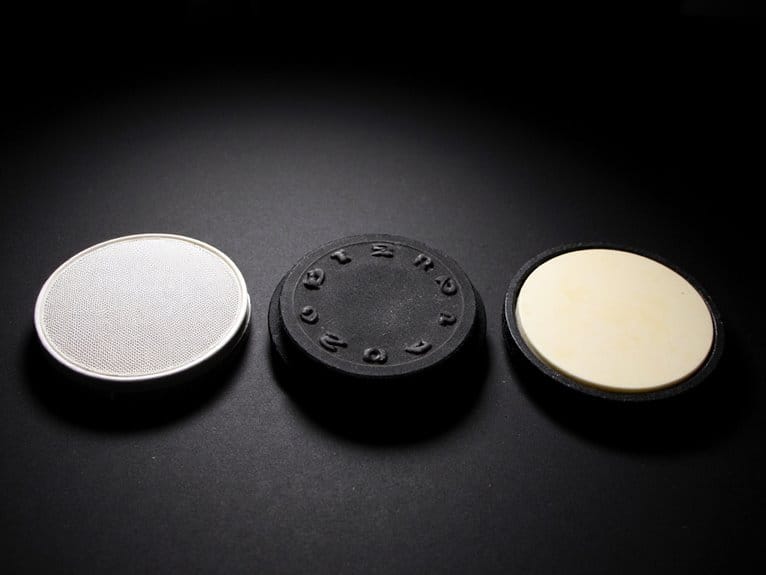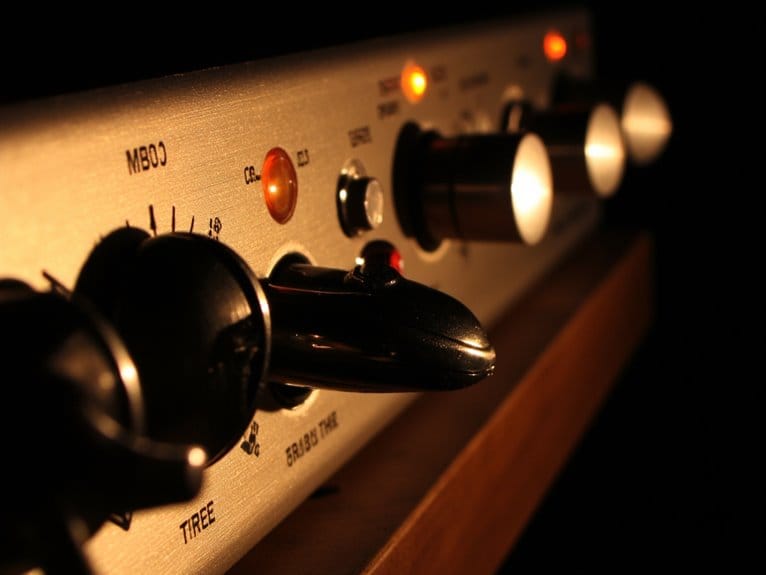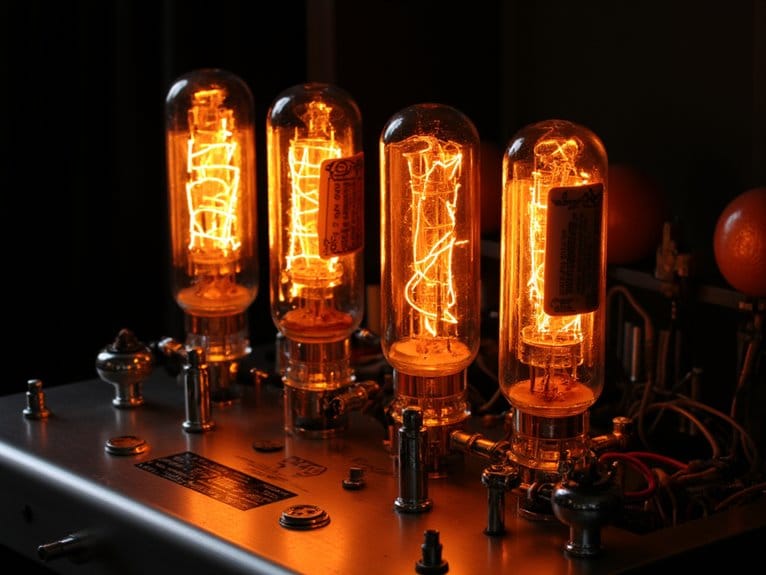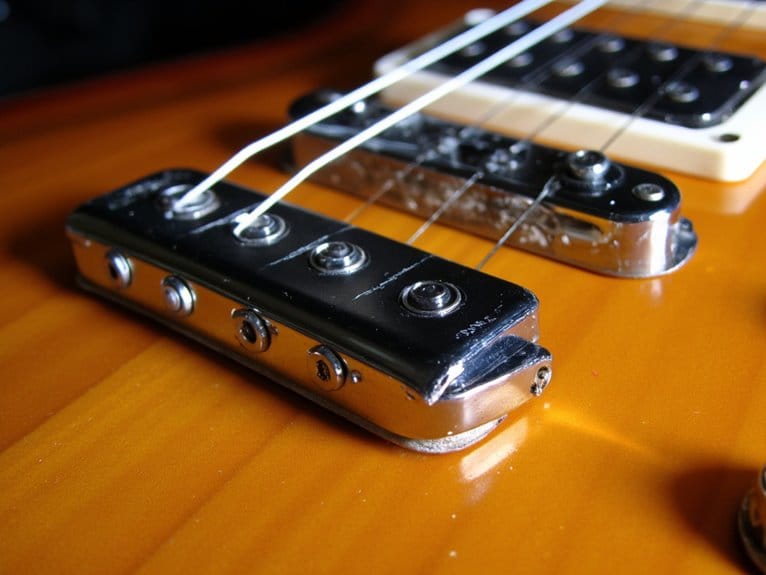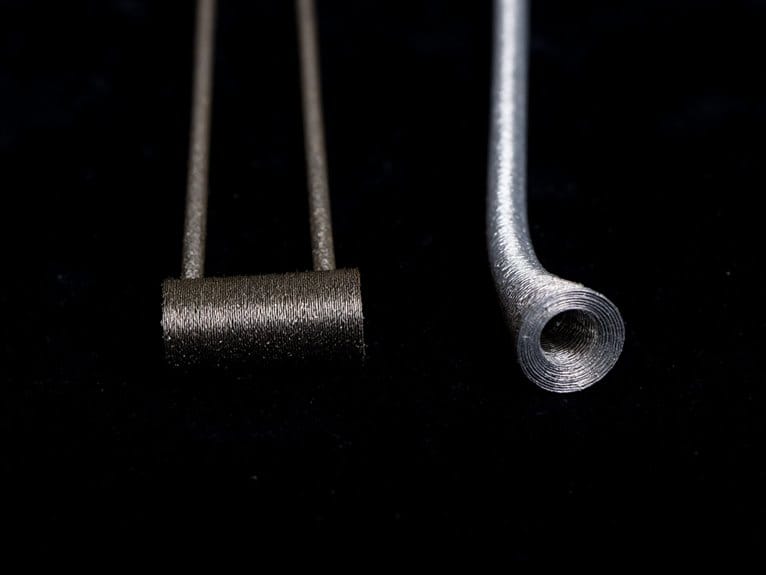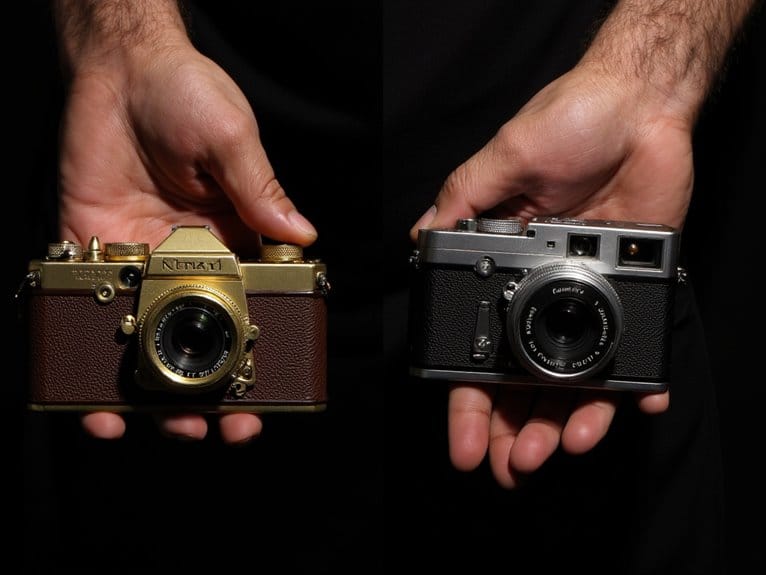Drum Pad Comparison: Mesh Vs Rubber Vs Hybrid Surfaces
When choosing drum pad surfaces, you’ll find mesh pads offer the most realistic acoustic feel with adjustable tension and superior dynamic sensitivity, making them ideal for expressive playing styles like jazz, though they’re pricier upfront. Rubber pads provide consistent, punchy responses perfect for rock genres and budget-conscious beginners, but they’re louder and less nuanced. Hybrid pads split the difference, combining durability with improved playability and multi-zone triggering, though they can’t match mesh precision. Your specific playing style, noise constraints, and budget will ultimately determine which surface delivers the performance characteristics that’ll transform your drumming experience.
We are supported by our audience. When you purchase through links on our site, we may earn an affiliate commission, at no extra cost for you. Learn more.
Notable Insights
- Mesh pads provide superior dynamic sensitivity and acoustic feel but may tear with heavy use and cost more initially.
- Rubber pads offer excellent durability and silent practice but have limited sensitivity and produce louder impact sounds.
- Hybrid pads balance performance and durability while featuring multi-zone triggering, though they lack mesh pad precision.
- Mesh surfaces excel in noise-sensitive environments due to superior vibration absorption and reduced stick impact noise.
- Cost-wise, rubber pads are cheapest upfront, mesh offers better long-term value, and hybrids provide intermediate pricing.
Playing Feel and Response Characteristics
When I first started comparing drum pads seriously, I discovered that the most essential factor isn’t the brand or price—it’s understanding how rebound and surface materials fundamentally shape your playing experience.
Mesh pads deliver adjustable tension that mimics acoustic drumheads, offering softer, more natural rebound with superior dynamic adaptability for rolls and ghost notes. You’ll notice reduced hand fatigue during extended sessions due to the flexible, porous material that absorbs stick energy effectively.
Rubber pads, conversely, provide firmer consistency but sacrifice rebound variability, feeling stiffer and less responsive to subtle playing nuances. While rubber offers controlled response, mesh’s tunability enables precise triggering and varied velocity response, making it remarkably more expressive for drummers seeking authentic acoustic simulation. However, rubber pads excel in silent practice environments where minimizing acoustic noise is the primary concern.
The distinct height differences between rim and head sections on mesh pads help prevent crosstalk issues that can plague electronic drum systems. Just as dynamic microphones excel in high sound pressure environments, mesh pads handle intense playing sessions while maintaining consistent responsiveness across all velocity levels.
Noise Levels and Sound Control
Beyond the tactile differences that influence your playing technique, I’ve found that noise control often becomes the deciding factor when you’re practicing in shared living spaces or late-night sessions.
Mesh pads excel in noise absorption, generating considerably less airborne sound due to their porous structure diffusing vibrations and stick impact noise. Meanwhile, rubber pads produce louder thudding sounds because of their dense, solid construction.
Mesh pads absorb noise through porous diffusion while rubber’s dense construction creates pronounced thudding sounds during practice sessions.
What’s particularly remarkable is how mesh heads provide superior vibration control, absorbing stick impact more effectively and reducing transmission through drum hardware to floors and adjacent rooms.
While both pad types remain drastically quieter than acoustic kits reaching 130 dB, mesh consistently outperforms rubber in overall sound management for noise-sensitive environments. This noise reduction makes mesh heads particularly ideal for apartments where sound isolation is crucial for maintaining good neighbor relationships.
Durability and Maintenance Requirements
When you’re investing in drum pads, understanding how they’ll hold up over months and years of regular practice becomes essential for making the right choice, since replacement costs and maintenance time can greatly impact your drumming budget and routine.
I’ve observed that different pad materials exhibit distinct wear patterns under various playing styles, with some requiring frequent adjustments while others maintain their performance characteristics for extended periods without intervention.
You’ll want to take into account both the immediate maintenance demands and long-term replacement costs, as these factors often determine whether your initial investment pays off or becomes an ongoing financial burden.
Long-Term Wear Patterns
Although I’ve tested countless drum pads over the years, I’ve learned that understanding long-term wear patterns remains one of the most essential factors in making a smart purchase decision.
Rubber pads develop distinct wear characteristics that include stick marks and surface indentations, though these cosmetic changes rarely impact performance even under high usage intensity.
Mesh surfaces show more dramatic deterioration patterns, with tension loss and potential tearing becoming apparent after extended heavy use. You’ll notice hybrid pads age more gracefully than pure mesh options, as their rubber edges protect the mesh center from premature wear.
Environmental factors accelerate aging across all pad types, but mesh variants suffer most from humidity fluctuations and temperature extremes.
Maintenance Cost Analysis
Your wallet’s long-term health depends heavily on understanding the ongoing maintenance costs associated with different drum pad technologies, since these expenses can quickly eclipse your initial purchase price over several years of regular use.
Mesh pads demonstrate superior cost efficiency through reduced maintenance frequency, requiring only occasional tension adjustments and cleaning supplies that’ll run you maybe twenty dollars annually.
Rubber surfaces, while cheaper upfront, demand more frequent replacements due to cracking and hardening, creating higher cumulative expenses. The cost implications become stark when you’re replacing rubber surfaces every two years versus mesh heads lasting five or more.
Hybrid pads occupy the middle ground, offering moderate durability but requiring attention to multiple material types, which can complicate maintenance schedules and increase overall care costs.
Budget electronic drum sets with dual-zone mesh pads provide enhanced longevity and reduced replacement costs compared to single-layer alternatives, making them particularly cost-effective for long-term ownership.
Cost Analysis and Value Proposition
Since I’ve spent countless hours comparing drum pad prices across different retailers and brands, I can tell you that the cost differences between mesh, rubber, and hybrid pads create distinct value tiers that directly impact your drumming experience and wallet.
Your cost comparison should consider that rubber pads often cost half the price of comparable mesh options, making them ideal for budget-conscious beginners who prioritize practice over professional feel.
However, your value assessment might favor mesh pads despite higher upfront costs, since replaceable heads extend lifespan and provide superior dynamic response for serious players.
Mesh pads deliver better value for serious drummers through replaceable heads and superior responsiveness despite higher initial investment.
Hybrid pads occupy the middle ground, offering enhanced playability at intermediate pricing, though premium materials can sometimes exceed mesh pad costs entirely.
Sound Triggering and Dynamic Sensitivity
Beyond the financial considerations, I’ve discovered that triggering performance and dynamic sensitivity represent the most significant functional differences between pad types, directly affecting how accurately your electronic kit translates stick strikes into sound output.
Mesh pads excel in sound dynamics, offering superior volume control from whisper-soft ghost notes to thunderous accents, while rubber surfaces provide narrower sensitivity levels with more consistent but less nuanced response. I’ve found mesh heads deliver fewer missed hits and false triggers, particularly during soft playing, thanks to their flexible surface structure that better replicates acoustic drum response.
Hybrid pads attempt bridging this gap through multi-zone triggering technology, though they can’t quite match mesh precision. Cross-talk issues also favor mesh, as their vibration-absorbing properties prevent unintentional triggering of adjacent pads.
Best Use Cases and Applications
Choosing the right drum pad type becomes clearer when you consider your specific drumming environment and goals, as I’ve learned through testing various setups across different scenarios. Expert recommendations consistently point toward mesh pads for serious practice and studio work, where their natural feel and noise reduction justify the higher cost. User experiences reveal rubber pads excel for beginners and budget-conscious drummers who prioritize durability over realism.
| Application | Best Choice | Key Benefit |
|---|---|---|
| Apartment practice | Mesh | Minimal noise transmission |
| Recording studio | Mesh | Reduced stick noise interference |
| Budget-conscious beginners | Rubber | Low cost, high durability |
Hybrid pads serve drummers seeking compromise between affordability and performance, though they rarely match mesh pads’ expressiveness or rubber’s maintenance-free reliability. Premium models with mesh heads typically feature dual-zone capabilities that detect subtle dynamic variations, making them essential for professional-level practice sessions. Modern drum kits feature USB, MIDI, and Bluetooth for seamless integration with recording software.
Making the Right Choice for Your Needs
When choosing the right drum pad, you’ll need to honestly evaluate your playing style preferences, practice habits, and skill development goals to determine which surface material best matches your specific requirements.
Your budget constraints will naturally narrow your options, but I’ve found that balancing initial cost against long-term durability often leads to better value decisions than simply choosing the cheapest option available.
Consider how frequently you’ll practice, whether noise reduction matters in your environment, and if you prioritize realistic acoustic feel over maximum durability, since these factors will guide you toward mesh, rubber, silicone, or hybrid surfaces.
Assess Your Playing Style
After years of testing countless drum pads in studios, practice rooms, and cramped apartments, I’ve learned that your playing style fundamentally determines which surface type will serve you best.
Your choice hinges on how you express yourself musically, the playing genres you favor, and your need for emotional expression through dynamics.
Consider these key style factors:
- Dynamic range needs – Jazz and blues players require subtle velocity variations that mesh surfaces excel at providing
- Playing intensity – Rock and electronic genres often benefit from rubber’s consistent, punchy response for aggressive hits
- Speed requirements – High-speed playing may favor firmer surfaces for precise stick control and immediate rebound
- Expression priority – Players emphasizing emotional expression through touch sensitivity should lean toward mesh or hybrid options
Modern MIDI drum pads offer velocity-sensitive technology that translates your physical playing dynamics into digital expression, making surface choice even more critical for optimal performance.
Similar to selecting cymbals where material and construction quality affects both durability and sonic richness, your drum pad surface choice directly impacts your practice effectiveness.
For jazz applications specifically, choosing the right surface becomes crucial since volume control and dynamic articulation are essential elements that distinguish great jazz performances from mediocre ones.
Your musical voice determines your ideal surface.
Budget and Longevity Balance
Budget constraints force you into decisions that’ll affect your drumming experience for years, and I’ve watched too many players regret choosing solely on price without considering long-term costs.
Rubber pads offer the most budget-friendly entry point, typically lasting thousands of strikes with minimal maintenance requirements, while mesh surfaces demand premium pricing but require periodic replacement and tension adjustments.
The budget implications extend beyond initial purchase costs—mesh pads’ superior feel comes with ongoing maintenance expenses that can double your investment over time.
My experience suggests rubber pads deliver the best longevity expectations for heavy practice sessions, often functioning throughout your kit’s entire lifespan.
Hybrid options split the difference, offering improved feel over rubber while maintaining better durability than mesh, though at increased complexity and cost.
Quality mesh pads like those found in models such as the Donner DED-300X and EASTROCK operate at impressively quiet levels below 37dB, making them ideal for apartment living despite their higher maintenance requirements.
Frequently Asked Questions
Do Mesh Pads Work With All Electronic Drum Modules and Brands?
Most mesh pads work across different electronic drum modules, but you’ll encounter compatibility issues with older units lacking dual-zone support. Brand differences in trigger types and wiring can affect performance despite standard connections.
On a final note
You’ll find that choosing between mesh, rubber, and hybrid drum pads ultimately depends on your specific priorities, budget constraints, and playing environment. If you’re prioritizing realistic stick response and don’t mind spending more, mesh surfaces deliver the most authentic acoustic feel. For budget-conscious drummers who need maximum durability and can tolerate slightly less nuanced dynamics, rubber pads remain a solid choice. Hybrid options offer the best compromise for most situations.

